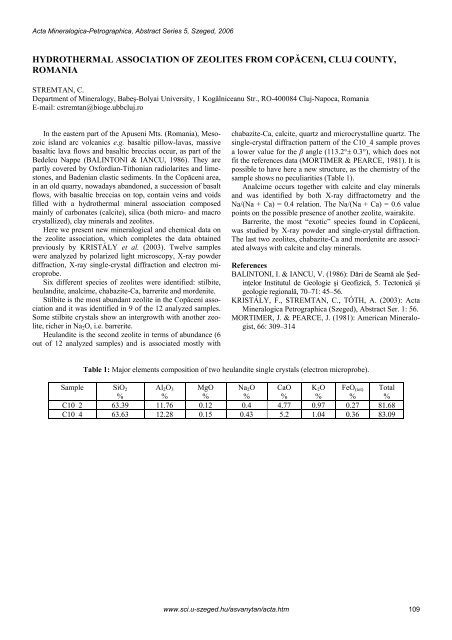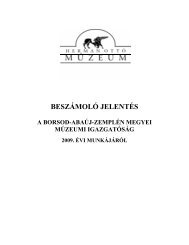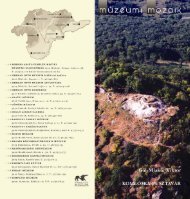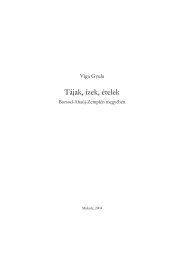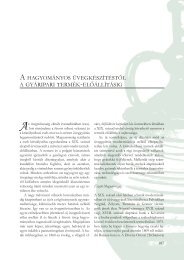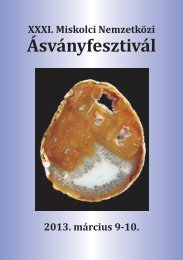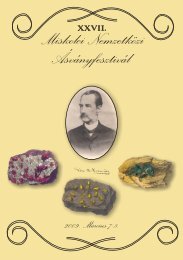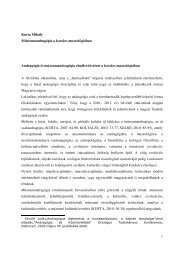Acta Mineralogica-Petrographica, Abstract Series 5, Szeged, 2006PRODUCTS OF PASSIVE TREATMENT OF ACID M<strong>IN</strong>E DRA<strong>IN</strong>AGE ANDTECHNOLOGICAL WASTEWATERŠOTTNÍK, P.Department of Mineral Deposits, Faculty of Natural Sciences, Comenius University, Mlynská dolina, 842 15 Bratislava,SlovakiaE-mail: sottnik@fns.uniba.skOutflows of acid mine drainage (AMD) represents seriousdanger for the environment as they cause pollution of surfaceand ground waters, soil degradation and changes invegetation. They can induce chemical decomposition of otherminerals, which can be the potential sources of toxicelements. Passive treatment systems (PTS) or constructedwetlands are artificial ecosystems, which simulate conditionstypical of natural wetlands based on observations of naturalprocesses. Consequently, the objective of metals treatment isoften to return mobile contaminants to their stable, immobilemineral forms. Many of these minerals are formed fromwater solution in a sedimentary environment, and thereactions are catalysed by bacteria. Mechanisms of retentionwithin wetlands listed in their order of importance includeformation of metal sulfides, formation and precipitation ofmetal hydroxides and carbonates:H 2 S + Zn 2+ → ZnS + 2H +Fe 2+ + HCO – 3 → FeCO 3 + H +3 HS – + 6 FeSO 4 + 4 CrO 2– 4 + 13 H 2 O + OH – → 3S 0 +2–6 Fe(OH) 3 + 4 Cr(OH) 3 + 6 SO 4Our first trial to use the PTS for cleaning of AMD wasrealised in the Šobov area, near the city of Banská Štiavnicain Slovakia. AMD outflow from waste dump has a pH about2.5 and the content of dissolved salts is over 20 g/l. Al, Feand SO 4 are the most common components found in AMD,which already affected over 145 000 m 2 of the site.Investigation of possible use of the PTS to treat AMD frommining waste dump in Šobov was realised in three steps. Thefirst step involved low-volume laboratory experiments. In thesecond step, a bench-scale system (capacity = 120 l) wasbuilt directly on the place of the planned PTS. At the sametime the third step was also carried out, in which the pilotPTS was gradually built. The pH in the system stayed alwaysat least at 4. We obtained good results of AMD treatment.Concentrations of Fe were many times reduced incomparison with original values. The same phenomena couldbe observed for Cu and Al, too. A considerable fall could alsobe measured in SO 2–4 concentrations, but in this case theefficiency of the PTS is a little lower.In the second experiment with the AMD from Smolníkwe concentrated on the bench-scale phase. A system with acapacity of 200 l filled with substrate composed of differentproportions of limestone, manure, sawdust and hay wereused. In all of the containers a tendency to progressiveimprovement of ability of the PTS to treat Fe, Cu, Zn and Alcontamination was observed, the efficiency in the final phaseof the experiment was 96–97%. On the other hand, theefficiency of the system to treat Fe and SO 4 2– was very low. Itwas caused by the very short time that was spent by thewastewater in the pilot-scale system.In the next project we tried to remove heavy metal fromtechnological wastewaters using an anaerobic bench-scaletreatment model (50 l) at Vanchang village in Vietnam. Afterone-month treatment, the concentrations of Cr, Ni, Fe, Al inour experimental model were significantly reduced; Cr from131 mg/l to 0.165 mg/l, Ni from 500 mg/l to 6.75 mg/l, Fefrom 1450 mg/l to 6.8 mg/l, Al from 224 mg/l to 1 mg/l. Theresults showed high efficiency in the removal of heavy metalsfrom wastewater and a prospect for expanding larger-scaletreatment in Vanchang and other places.In the last project we focused on treatment of water froma technological waste dump in Bošany (Slovakia). Thebiological treatment of chromium was used for reduction ofCr 6+ to Cr 3+ .ReferencesKONOPELEC, J. (2004): Passive treatment of Cr and Ascontaminated wastewater. Department of MineralDeposits, Faculty of Natural Sciences, ComeniusUniversity, Bratislava. Manuscript (MSc Thesis, inSlovak), 71 p.ŠOTTNÍK, P. (2000): Passive treatment of acid minedrainage (PhD theses). Department of Mineral Deposits,Faculty of Natural Sciences, Comenius University,Bratislava. Manuscript (PhD thesis, in Slovak), 116 p.ŠOTTNÍK, P. & ŠUCHA, V. (2000). Experiences with an insituand passive treatment of heavy metal polluted water –a possibility also for the Nam Dinh region? In: Book ofAbstracts, International Workshop on EnvironmentalProtection, Community Health for SustainableDevelopment of Craft-settlements in Nam Dinh, 26–27October 2000, Nam Dinh, Vietnam.WILDEMAN, T. R. & UPDEGRAFF, D. M. (1997): In:MACALADY, D. L. (ed.): Perspectives in environmentalchemistry. Oxford: Oxford University Press, 473-495.108www.sci.u-szeged.hu/asvanytan/acta.htm
Acta Mineralogica-Petrographica, Abstract Series 5, Szeged, 2006HYDRO<strong>THE</strong>RMAL ASSOCIATION OF ZEOLITES FROM COPĂCENI, CLUJ COUNTY,ROMANIASTREMTAN, C.Department of Mineralogy, Babeş-Bolyai University, 1 Kogălniceanu Str., RO-400084 Cluj-Napoca, RomaniaE-mail: cstremtan@bioge.ubbcluj.roIn the eastern part of the Apuseni Mts. (Romania), Mesozoicisland arc volcanics e.g. basaltic pillow-lavas, massivebasaltic lava flows and basaltic breccias occur, as part of theBedeleu Nappe (BAL<strong>IN</strong>TONI & IANCU, 1986). They arepartly covered by Oxfordian-Tithonian radiolarites and limestones,and Badenian clastic sediments. In the Copăceni area,in an old quarry, nowadays abandoned, a succession of basaltflows, with basaltic breccias on top, contain veins and voidsfilled with a hydrothermal mineral association composedmainly of carbonates (calcite), silica (both micro- and macrocrystallized), clay minerals and zeolites.Here we present new mineralogical and chemical data onthe zeolite association, which completes the data obtainedpreviously by KRISTÁLY et al. (2003). Twelve sampleswere analyzed by polarized light microscopy, X-ray powderdiffraction, X-ray single-crystal diffraction and electron microprobe.Six different species of zeolites were identified: stilbite,heulandite, analcime, chabazite-Ca, barrerite and mordenite.Stilbite is the most abundant zeolite in the Copăceni associationand it was identified in 9 of the 12 analyzed samples.Some stilbite crystals show an intergrowth with another zeolite,richer in Na 2 O, i.e. barrerite.Heulandite is the second zeolite in terms of abundance (6out of 12 analyzed samples) and is associated mostly withchabazite-Ca, calcite, quartz and microcrystalline quartz. Thesingle-crystal diffraction pattern of the C10_4 sample provesa lower value for the β angle (113.2°± 0.3°), which does notfit the references data (MORTIMER & PEARCE, 1981). It ispossible to have here a new structure, as the chemistry of thesample shows no peculiarities (Table 1).Analcime occurs together with calcite and clay mineralsand was identified by both X-ray diffractometry and theNa/(Na + Ca) = 0.4 relation. The Na/(Na + Ca) = 0.6 valuepoints on the possible presence of another zeolite, wairakite.Barrerite, the most “exotic” species found in Copăceni,was studied by X-ray powder and single-crystal diffraction.The last two zeolites, chabazite-Ca and mordenite are associatedalways with calcite and clay minerals.ReferencesBAL<strong>IN</strong>TONI, I. & IANCU, V. (1986): Dări de Seamă ale ŞedinţelorInstitutul de Geologie şi Geofizică, 5. Tectonică şigeologie regională, 70–71: 45–56.KRISTÁLY, F., STREMTAN, C., TÓTH, A. (2003): ActaMineralogica Petrographica (Szeged), Abstract Ser. 1: 56.MORTIMER, J. & PEARCE, J. (1981): American Mineralogist,66: 309–314Table 1: Major elements composition of two heulandite single crystals (electron microprobe).Sample SiO 2%Al 2 O 3%MgO%Na 2 O%CaO%K 2 O%FeO (tot)%Total%C10_2 63.39 11.76 0.12 0.4 4.77 0.97 0.27 81.68C10_4 63.63 12.28 0.15 0.43 5.2 1.04 0.36 83.09www.sci.u-szeged.hu/asvanytan/acta.htm 109
- Page 1:
MSCC33 rd MINERAL SCIENCES IN THE C
- Page 5 and 6:
Acta Mineralogica-Petrographica, Ab
- Page 7 and 8:
Acta Mineralogica-Petrographica, Ab
- Page 9 and 10:
Acta Mineralogica-Petrographica, Ab
- Page 11 and 12:
Acta Mineralogica-Petrographica, Ab
- Page 13 and 14:
Acta Mineralogica-Petrographica, Ab
- Page 15 and 16:
Acta Mineralogica-Petrographica, Ab
- Page 17 and 18:
Acta Mineralogica-Petrographica, Ab
- Page 19 and 20:
Acta Mineralogica-Petrographica, Ab
- Page 21 and 22:
Acta Mineralogica-Petrographica, Ab
- Page 23 and 24:
Acta Mineralogica-Petrographica, Ab
- Page 25 and 26:
Acta Mineralogica-Petrographica, Ab
- Page 27 and 28:
Acta Mineralogica-Petrographica, Ab
- Page 29 and 30:
Acta Mineralogica-Petrographica, Ab
- Page 31 and 32:
Acta Mineralogica-Petrographica, Ab
- Page 33 and 34:
Acta Mineralogica-Petrographica, Ab
- Page 35 and 36:
Acta Mineralogica-Petrographica, Ab
- Page 37 and 38:
Acta Mineralogica-Petrographica, Ab
- Page 39 and 40:
Acta Mineralogica-Petrographica, Ab
- Page 41 and 42:
Acta Mineralogica-Petrographica, Ab
- Page 43 and 44:
Acta Mineralogica-Petrographica, Ab
- Page 45 and 46:
Acta Mineralogica-Petrographica, Ab
- Page 47 and 48:
Acta Mineralogica-Petrographica, Ab
- Page 49 and 50:
Acta Mineralogica-Petrographica, Ab
- Page 51 and 52:
Acta Mineralogica-Petrographica, Ab
- Page 53 and 54:
Acta Mineralogica-Petrographica, Ab
- Page 55 and 56:
Acta Mineralogica-Petrographica, Ab
- Page 57 and 58: Acta Mineralogica-Petrographica, Ab
- Page 59 and 60: Acta Mineralogica-Petrographica, Ab
- Page 61 and 62: Acta Mineralogica-Petrographica, Ab
- Page 63 and 64: Acta Mineralogica-Petrographica, Ab
- Page 65 and 66: Acta Mineralogica-Petrographica, Ab
- Page 67 and 68: Acta Mineralogica-Petrographica, Ab
- Page 69 and 70: Acta Mineralogica-Petrographica, Ab
- Page 71 and 72: Acta Mineralogica-Petrographica, Ab
- Page 73 and 74: Acta Mineralogica-Petrographica, Ab
- Page 75 and 76: Acta Mineralogica-Petrographica, Ab
- Page 77 and 78: Acta Mineralogica-Petrographica, Ab
- Page 79 and 80: Acta Mineralogica-Petrographica, Ab
- Page 81 and 82: Acta Mineralogica-Petrographica, Ab
- Page 83 and 84: Acta Mineralogica-Petrographica, Ab
- Page 85 and 86: Acta Mineralogica-Petrographica, Ab
- Page 87 and 88: Acta Mineralogica-Petrographica, Ab
- Page 89 and 90: Acta Mineralogica-Petrographica, Ab
- Page 91 and 92: Acta Mineralogica-Petrographica, Ab
- Page 93 and 94: Acta Mineralogica-Petrographica, Ab
- Page 95 and 96: Acta Mineralogica-Petrographica, Ab
- Page 97 and 98: Acta Mineralogica-Petrographica, Ab
- Page 99 and 100: Acta Mineralogica-Petrographica, Ab
- Page 101 and 102: Acta Mineralogica-Petrographica, Ab
- Page 103 and 104: Acta Mineralogica-Petrographica, Ab
- Page 105 and 106: Acta Mineralogica-Petrographica, Ab
- Page 107: Acta Mineralogica-Petrographica, Ab
- Page 111 and 112: Acta Mineralogica-Petrographica, Ab
- Page 113 and 114: Acta Mineralogica-Petrographica, Ab
- Page 115 and 116: Acta Mineralogica-Petrographica, Ab
- Page 117 and 118: Acta Mineralogica-Petrographica, Ab
- Page 119 and 120: Acta Mineralogica-Petrographica, Ab
- Page 121 and 122: Acta Mineralogica-Petrographica, Ab
- Page 123 and 124: Acta Mineralogica-Petrographica, Ab
- Page 125 and 126: Acta Mineralogica-Petrographica, Ab
- Page 127 and 128: Acta Mineralogica-Petrographica, Ab
- Page 129 and 130: Acta Mineralogica-Petrographica, Ab
- Page 131 and 132: Acta Mineralogica-Petrographica, Ab
- Page 133 and 134: Acta Mineralogica-Petrographica, Ab


